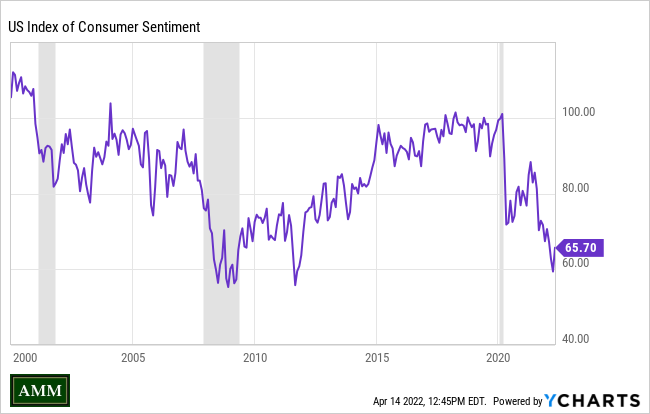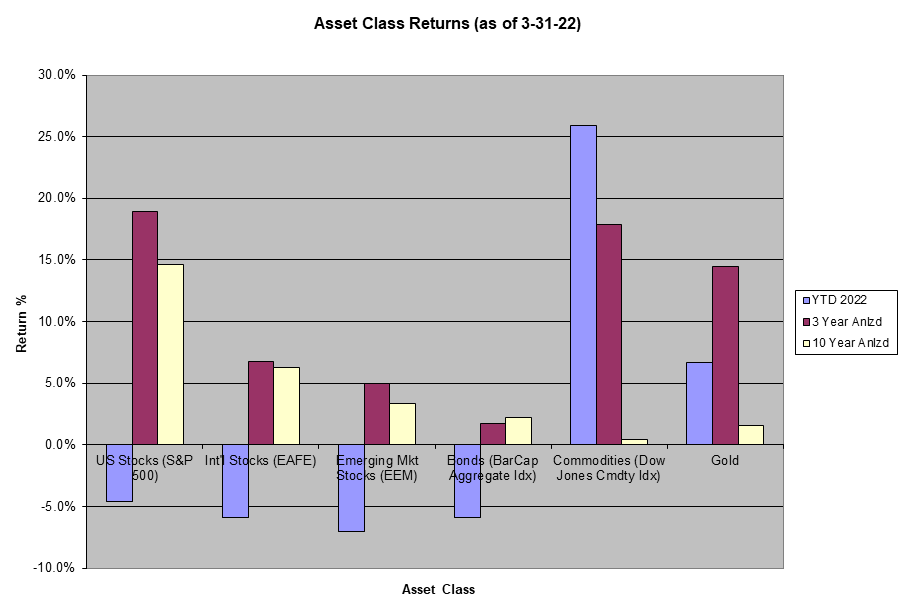The Big Picture ~ Recessions and Bear Markets
This year, the S&P 500 peaked on January 3rd at an all-time high of 4,796. Since then the index has dropped 4.6% through the end of March. This is a relatively modest decline from all-time highs, especially given the backdrop of high inflation, rising rates, and geopolitical turmoil. In this letter we endeavor to provide a sober assessment of the current economic and market environment. We conclude that the risk of recession and/or bear market is elevated, though not a foregone conclusion.
None of this is to say that long term investors should attempt to exit the market by jettisoning their well-conceived portfolio strategy. We do not try to predict the unknowable; the future always consists of a range of possible and unknowable outcomes. Instead we do our best to understand the current environment with regard to where the risk of potential outcomes may be rising or falling; and then position portfolios accordingly. Understanding today is our best bet for preparing for the future.
The Economy: Elevated Recession Risks 2022-2023
First it is important to note that recessions are incredibly hard to predict. As Nobel economist Paul Samuelson once joked, “economists have predicted 9 of the last 5 recessions”. Rather than predict, we seek to understand where risks of a potential recession may have risen. Some of these known risks include:
- The Consumer: Rising inflation has weighed on consumer expectations. The University of Michigan Consumer Sentiment index fell from 88.3 a year ago to 65.7 during March 2022, the lowest reading since November 2011 (Exhibit A), and in the range of sentiment readings seen throughout the Great Recession of 2008/09. Any strength in personal income may be quickly whittled away when adjusted for inflation. The risk of inflation outrunning the consumer has risen.
- Federal Reserve: The “Fed” is embarking on a dramatic shift in policy – from a regime of aggressive stimulus to one of aggressive tightening. Given that both the markets and the economy boomed following the COVID-driven stimulus regime, shall we expect an equal and opposite reaction from a tightening regime? Either way, given the hot inflation prints of recent months it appears that the Fed provided too much stimulus for too long. To retain credibility the Fed is now in the tough position of proving that they can be tough on inflation without pushing the economy in to recession.
- Politics: If push comes to shove, it appears likely that the current administration may choose a recession over runaway inflation. A cyclical recession can always be blamed on the business cycle – recessions are part of economic life. But runaway inflation, food shortages, etc. are recipe for political disaster.
- Geopolitics/War: We put this risk in the known-unknown camp – everyone knows it is a risk, but just how risky? This is especially hard to decipher. Those who are doomsday-inclined can take this risk to as dark a place as they can imagine. We are left only to say that this is a tragedy in real time – and from a risk perspective increases the odds of more volatility.
This is not an exhaustive list, but these are some of the biggest risks facing investors. It is no wonder that in a CNBC poll given in March, 81 percent of US adults said they believe a recession is likely in 2022. Or as economist Ed Yardeni recently wrote in a research note, “if a recession is coming, it will be among the most widely anticipated downturns in history”. For his part, Yardeni places the odds of a recession between now and year-end 2023 at 30%. Consider some counterpoints to the recession risks highlighted above:
- Money supply: Recent data show M2 money supply (US cash, CDs, checking and savings deposits, and money market funds) nearly $3 trillion above the pre-COVID trend. This represents a significant amount of “excess” liquidity to support consumption in the face of rising prices.
- Corporate Profits: Recent data show that corporate revenue growth, profit growth and profit margins for publicly traded large, mid and small-cap (S&P 500/400/600) companies are at all-time highs – even after a year of steadily rising inflation. So far companies have been able to protect their margins and pass through higher input costs.
- Peak inflation: Fears that we are now in an unrelenting new inflation paradigm may be overdone. In fact this month will begin a period where future year over year inflation numbers will become “easier” since the starting value will be from a higher level. Most economists expect inflation to remain well above the Fed’s 2% target this year, but to come down significantly in the second half of the year. Could softening inflation allow more dovish voices to assert themselves at the Fed? Even if inflation only comes down marginally, the softening trend could conceivably ease the level of tightening expected at the Fed.
- Credit Cycle: The worst recessions are driven by a busting of the credit cycle. So far key metrics like defaults, bankruptcy filings, high yield bond spreads and corporate profitability show little signs of credit stress.
Bear Markets (Recessions Optional)
History suggests that bear markets, a stock market decline of 20% or more, always accompany recessions – a contraction in economic growth. But a recession is not required for a bear market to ensue. Recessions, by definition, reflect a decline in the real economy. Publicly traded stocks represent a large portion of the growth in the economy. As earnings decline in an economic contraction, so do stock prices. But sometimes stocks sell off in advance of a recession that never actually comes to fruition. Stocks trade on expectations and expectations are not always correct.
Bear markets are fairly common, occurring around every 7 years on average since 1946. This describes market volatility, but not a real bear market. A real bear market is characterized by both depth and duration; lasting 12 months or longer. Since World War II there a have been 6 bear markets that lasted a year or longer, occurring approximately every 13 years. The longest of these followed the bursting of the tech bubble in 2000 and took over 2 ½ years to reach its nadir before turning higher. The deepest occurred during the 2008 financial crisis with a declined of ~56.8% peak to trough.
The duration ultimately leads to frustration as investors tire of negative returns on their statements, and begin to question the entire validity of investing at all. “I’d do better with my money under a mattress!” becomes the rallying cry as the bear market grinds on. This frustration finally leads to capitulation whereby the frustrated investor throws in the towel – perhaps near market lows. Thoroughly disgusted with the experience, the capitulating investor avoids market risk for years to come – missing out on the inevitable transition to recovery and a new bull market.
While long duration bear markets are infrequent, they happen often enough that we need to recognize that they exist, and are likely to happen multiple times during our investing lifetime. Bear markets are fraught with danger, but not entirely because of declining prices. Most of the danger comes in how we respond to these prices, or behavioral risk. Panic selling of otherwise good assets is not a strategy, and usually leads to longer term wealth destruction.
Bear Market Prep
The best way to prepare for a bear market is in advance. The first and most important decision is to ensure that you asset allocation is appropriate for your age, time horizon, risk tolerance and financial circumstances. Beyond prudent asset allocation we seek to deploy the following strategies to effectively manage through the next bear market – whenever it rears its head:
- Continue to Invest & Rebalance: The price you pay determines your return. Bear markets provide an opportunity for bargain hunting. Too often investors sideline themselves just as the stock market begins providing better value and more opportunity for growth. If you regularly contribute to your 401k, IRA or other investment account, do not stop during a bear market. Even fully invested portfolios can take advantage of bargain hunting via prudent rebalancing in to positions that have declined, and now offer higher prospective returns going forward.
- Tax Loss Harvesting: Bear Markets provide investors the opportunity to strategically “harvest” losses from their portfolios. The securities sold at a loss can be replaced by a similar but not identical security, so the portfolio will participate in a market rebound. Losses can be used to offset future capital gains and/or a portion (currently $3,000/year) can be used as a deduction against income.
- Over-allocate to Risk Assets: This is the equivalent of “turning in to the crash” as your car swerves on a slippery road. It may feel counterintuitive at the time, but by overweighting your portfolio to stocks as a Bear Market progresses, investors can set themselves up for greater upside once a more sustainable recovery takes hold. There is no way to perfectly time the implementation of this strategy, but the steeper the market decline, the more aggressive we will seek to be in shifting to an overweight stock position.
Year to date Returns & Current Positioning
Year to date through 3/31/22
- Domestic stocks (S&P 500) declined 4.6%
- Developed international stocks (EAFE) declined 5.9%
- Emerging market stocks (EEM) declined 7.0%
- Bonds (Bar Cap Aggregate) declined 5.9%
- Commodities (DJCI) were up 25.9%
- Gold was up 6.7%
We have updated our asset class return chart to reflect year-to-date returns through March, along with three and ten year annualized returns for the aforementioned asset classes.
Over the 10 year period ending March 31, 2022 US stocks have annualized average returns of nearly 15% per year. This is more than 50% higher than the long-term average returns since the 1920s. What was so great about the last decade that justified such high returns? There is a cynical view that the great US stock boom of the last ten years was mostly due to dovish central bankers. Maintaining easy monetary policy and stepping in every time markets got wobbly to save markets – the proverbial Fed Put. A less cynical view is that “money goes where it is treated best”, low yielding government bonds – negative for many sovereigns, pushed more and more capital in to riskier assets like stocks thus driving prices higher. Another popular view is that US stocks, after performing so miserably in the ten years prior, were simply making up for lost time.
Whatever the reason, large-cap US stocks ended 2021 near some of their highest valuations in history. Much of this “frothy” valuation was concentrated in the 8 largest companies in the S&P 500. These are strong companies, a few of which we have invested in directly in our firm’s dividend growth strategy portfolios. We still must recognize that high current prices generally mean lower future returns.
The good news is that underneath the surface there is still value to be found in stocks. Small and mid-cap stocks have seen earnings and revenues continue to move higher over the last few years, but their valuations have not kept pace. Likewise, value stocks have been major underperformers over the past decade leaving them with more reasonable valuations relative to their growthier peers. In asset allocation portfolios we continue to tilt towards value oriented stocks within the large-cap space, and include exposure to mid and small-cap companies where consistent with a client’s risk tolerance and objectives. We also continue to allocate to international developed and emerging markets – these stocks continue to trade at historic discounts to their domestic counterparts. Recent global turmoil has tempered our near-term enthusiasm for these markets; but we continue to view the risk/reward in these markets as favorable over a longer time horizon.
For many years we have focused on maintaining lower duration and shorter maturity exposure for fixed income oriented allocations. At times this meant foregoing higher returns in longer-duration bonds, as interest rates remained persistently low. However, in the first quarter interest rates took flight. While our shorter duration basket was not left unscathed, it did weather the first quarter bond rout relatively well. Despite the difficult environment for bonds this year, we continue to view fixed income oriented investments as critical portfolio diversifiers and risk ballasts. Intermediate and shorter-term investment grade bonds (those issued by both governments and corporations) have historically exhibited a fraction of the volatility of stocks. Corporate bonds are higher on the capital structure than stocks, and can act as a source of opportunity capital in the event of a more pronounced stock market sell-off.
Should you have any questions regarding your investment account(s) and personal financial plans, or if there have been any recent changes to your investment and/or retirement objectives, please contact our office to speak with one of us at your convenience. We can also provide you with a current copy of our SEC Form ADV Part 2, at your request.
As always, we thank you for entrusting AMM to help you achieve your investment and retirement objectives.
Your Portfolio Management Team
Individual accounts will vary based on a client’s stated investment objectives, risk tolerance and time frame. We manage several different strategies, so not every client will have exposure to the securities, asset classes or investment strategies described above. In addition to growth and/or income oriented asset allocation strategies, we also manage more concentrated equity portfolios that generally carry a higher degree of risk and volatility. For qualified investors, we periodically recommend short-term first trust deed investments secured by real estate that pay monthly distributions. Let us know if you want to discuss your specific portfolio strategy in greater detail.





